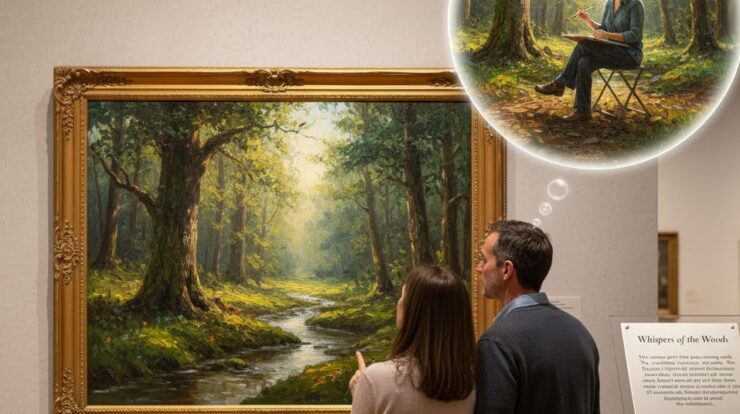
Over the last two articles, we’ve explored why writing about your art clarifies your vision and how an authentic artist statement helps others connect with your work. Both conversations point toward a deeper truth: art doesn’t exist in isolation. It lives at its fullest when there’s a pathway for the viewer to step inside.
That pathway isn’t built with long explanations or heavy analysis—it’s built with context. A title, a few lines of background, or a brief insight into your process can change the entire emotional experience of a piece. Viewers always bring their own thoughts and history, but a little story gives them a place to stand before their imagination takes over.
Guiding vs. Telling
One concern artists often voice is, “I don’t want to over-explain—I want people to find their own meaning.” And they will. Nothing you say can stop a viewer from bringing their own memory, mood, or story to your work.
But there’s a difference between telling someone what a piece means and guiding them into it.
Guiding sounds like:
-
“This grew out of a quiet morning walk.”
-
“I was thinking about resilience.”
-
“The colors came from a moment I couldn’t shake.”
These lines don’t prescribe a meaning. They simply help the viewer slow down, shift their attention, and notice more.
Telling would be:
-
“This painting represents the inevitability of loss.”
That kind of statement closes a door. Guiding opens one.
A Touch of Story Deepens, Not Limits, Interpretation
Interpretation doesn’t shrink when you offer context—it expands.
A title or backstory doesn’t restrict the viewer; it gives them a foothold. In one of our recent discussions, someone pointed out how a simple detail—the reason a figure’s swimsuit shared its color with the surrounding landscape—completely transformed how they saw the painting. The image went from “pleasant beach scene” to something resonant, symbolic, and thoughtful.
It didn’t limit their interpretation.
It unlocked it.
If viewers were going to bring their own history to the painting anyway, why not give them a starting point that helps them enter the work with greater attention?
Museums Already Know This
Walk into any major museum and notice how much thought goes into wall labels. They’re short—often under 100 words—but incredibly intentional. They rarely tell the visitor what the work “means.” Instead they:
-
Provide a sliver of history
-
Point to a detail worth noticing
-
Offer a clue about the artist’s intention
-
Create atmosphere
Museums understand that viewers often rush. A few sentences slow them down long enough to truly see.
As artists, you can use the same approach. Give viewers just enough direction to shift them from “glance” mode into something deeper.
Context Encourages Empathy
A small story creates a human bridge between artist and audience. It reminds the viewer there’s a person behind the work—someone who made choices, wrestled with ideas, and felt something powerful enough to translate into form.
That reminder subtly increases empathy.
Empathy increases engagement.
And engagement increases the likelihood that a viewer will stay with your work long enough for it to matter.
This isn’t marketing; it’s connection.
Building on What We’ve Covered
In How Writing About Your Art Deepens How You See It, we looked at how reflection sharpens your own understanding of your work.
In How to Write an Artist Statement That Actually Connects, we focused on finding the right words—clear, concise, sincere.
This next step is about using those insights to shape the viewer’s experience. You’re not telling them what to think. You’re handing them a small light so they’re not stepping into your world in the dark.
A painting, sculpture, or photograph always stands on its own. But when you pair it with a thoughtful title, a few lines of context, or a note about what sparked it—the piece breathes differently. It becomes a conversation instead of a monologue.
How do you help viewers enter your work? Do you offer titles, stories, or descriptions—or do you let the art speak entirely on its own? I’d love to hear how you approach this balance.
